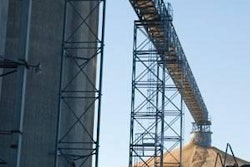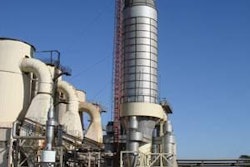.jpg?auto=format%2Ccompress&q=70&w=400)
After energy and protein, phosphorus is the third most costly nutrient in pig and poultry feeds. An essential nutrient, phosphorus plays a key role in bone and egg shell formation and energy metabolism.
The average broiler grown to 42 days of age will consume around 26g of phosphorus (P) and of this, around 40 percent (10 g) will be provided by inorganic phosphorus sources. For an integrator producing 1 million broilers per week, that's equivalent to around US$1.2 million per year for inorganic P sources. Some of this is consumed as plant phosphorus, of which around 70 percent is not digested by the animal, and some will be inorganic phosphorus from mineral sources such as calcium phosphate, of which around 15-20 percent will remain undigested.
Costs of undigested phosphorus
Undigested phosphorus passes through the animal's gut, ultimately causing problems for the environment by polluting water courses. In addition, as the cost of feed ingredients continues to rise, and inorganic phosphates become relatively more expensive, there are significant economic considerations to take into account.
Phytase enzymes are commonly added to feed to improve the digestibility and availability of phosphorus from plant sources. Phytases reduce the amount of inorganic phosphorus that needs to be added to the feed to meet the animal's phosphorus requirement, resulting in reduced feed costs and less phosphorus excretion into the environment.
The first major phytases in commercial use were derived from different species of fungi. Today, additional options are available with some of the newer products available being derived from a bacterial source. To fully embrace the greater potential of newer phytase products, poultry and pig producers can make greater reductions in dietary inorganic phosphorus, energy and amino acids. According to the latest feed ingredient prices, producers can reduce feed costs by around US$5.00 per tonne of feed while ensuring that there is no detrimental effect on animal performance.
However, in order to maximize the potential benefits offered by these new-generation phytase products, it is vital to compare them with traditional phytases when formulating pig and poultry diets.
Compared to traditional fungal phytases, it is claimed that E. Coli phytase is more resistant to breakdown by the animal's own pancreatic proteases, and that it has a higher relative activity over a wider pH range in the gut, suggesting they may be more effective throughout the digestive system compared to other leading phytase products.
Enzyme heat stability
To avoid the potential complications associated with post-pelleting liquid enzyme application systems, proven enzyme heat stability remains a key requirement for the feed industry to allow direct enzyme addition into the mixer, ahead of the conditioning and pelleting process.
In choosing a phytase enzyme, heat stability should be considered when comparing products. Look for a product backed by independent research supporting claims of protection from high temperatures. As one example, Danisco's new Thermo Protection Technology (TPT) delivers a free-flowing, dust-free phytase granulate product that maintains efficiency even after exposure to feed conditioning and pelleting temperatures of up to 95°C (203°F), allowing effective use of this dry product in the majority of feed manufacturing processes. Such heat stability should be an important consideration in choosing a phytase.
Ensure that claims of heat stability are backed by research and a proven process. An example of a proven process would be one that applies a coating to the phytase enzyme to protect against the high temperatures that typically occur during the feed pelleting process, while still rapidly releasing the enzyme activity where needed in the animal's gut. Such a process should be backed by independent trials. In this example, the coated phytase was included in the feed prior to conditioning and pelleting at temperatures of 90°C (194°F) or 95ºC (203ºF) and with a conditioning time of 30 seconds. Relative to unprocessed mash feed, 99 percent of the phytase activity remained after conditioning and pelleting at 90°C (194°F), while at 95°C (203ºF) 96 percent of the phytase activity remained. Numerous pelleting trials comparing the heat stability of a new coated phytase with three other commercially available heat-stable phytases showed that the new-generation product retained approximately 2055 percent more phytase activity at 90°C (194°F) and approximately 20 65 percent more phytase activity at 95ºC (203ºF).
Recent pelleting trials at various feed mills throughout the US confirmed the high heat stability of the coated phytase. In 26 commercial mill tests, where feed was pelleted between 85-95°C, on average 83 percent of the phytase activity remained after conditioning and pelleting relative to unprocessed mash feed.
Animal trials have confirmed that the new-generation phytase releases effectively in the intestine, with no detrimental effects on phytase efficacy in the animal. Broiler and piglet studies conducted by The Agricultural Development and Advisory Service (ADAS) in the UK and the Universities of Manitoba and Alberta in Canada confirmed no significant differences in live weight gain, feed conversion ratio (FCR) or tibia ash in birds and piglets fed either the uncoated or coated phytase, confirming that the coating allows the phytase to be released effectively in the animal's gut.
Table 1: Coated phytase is as effective in the animal as uncoated phytase
Minimizing environmental impact
Increasing legislative pressures will undoubtedly force producers to focus further on reducing the environmental impact of their farms. Producers should therefore embrace and fully exploit technologies which reduce the risk of damaging the environment.
Phytases which are proven to be more effective at releasing phosphorus from feed ingredients will help producers to reduce phosphorus pollution. Increasing the amount of phytase included in the feed also provides opportunities for producers to further reduce the amount of phosphorus excreted into the environment.
Maximize feed savings
Maximizing feed cost savings while incorporating phytases is important to their use. One method available is the Phycheck optimization service from Danisco Animal Nutrition which enables feed manufacturers, together with pig and poultry producers, to maximize feed cost savings when using its phytase product. It employs a unique software program which calculates customer-specific matrix values for phosphorus, calcium, amino acids and energy according to the level of dietary phytate phosphorus, phytase dose rate and economic considerations. The service was developed from extensive digestibility trials conducted globally that contributed a total of over 100 individual data points each for broilers, layers and pigs.
The optimization service employs a "multi-factorial model" to describe the animal responses to phytase based on these trials. For example, improvements in energy (AME) and amino acid digestibility, according to phytase dose rate (250 1000 FTU/kg feed). For broiler and layer feeds, the effect of dietary phytate phosphorus level (0.23 - 0.33 percent) is also accounted for, as is the effect of bird age in broilers (0-21 days or 22-42 days).
The model indicates improvements in dietary energy (AME), ileal protein and amino acid digestibility at all phytate concentrations. There are also significant interactions between phytate level and phytase dose rate. The new software takes into account these complex inter-relationships when calculating the specific matrix values for phosphorus, calcium, amino acids and energy for a particular diet.
Feed producers under pressure to maximize feed cost savings need a method to confidently apply phosphorus, calcium, energy and amino acid matrix values, thereby fully exploiting the cost-saving potential of phytase, without risking animal performance. As phytase use continues to grow throughout the world and product choice becomes more diverse, so does the need for reliable tools to enable feed producers to compare and optimize phytase use for maximum economic benefit.
.jpg?auto=format%2Ccompress&crop=faces&fit=crop&h=48&q=70&w=48)



.jpg?auto=format%2Ccompress&fit=crop&h=167&q=70&w=250)











